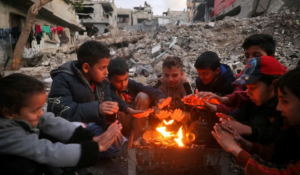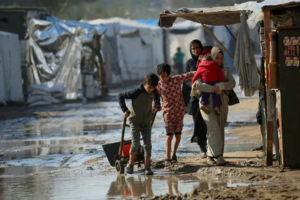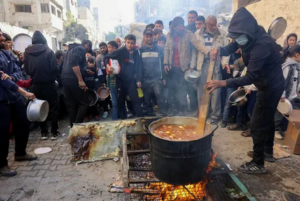Gaza’s man-made humanitarian crisis is the disaster everyone warned about

Children warm by the fire at the Bureij camp for displaced Palestinians on 30 December 2024
Nir Hasson writes in Haaretz on 31 December 2024:
One million people live in Jerusalem including thousands of children, 15,000 pregnant women and at least 100,000 elderly, disabled, chronically ill cancer patients, diabetics and people suffering from mental illnesses. Just like any large city in the world.
Now imagine taking all of Jerusalem’s residents from their homes and putting them in tents on the beach. Now add all of Tel Aviv and Haifa’s residents to this huge tent city.
That is the scale of the tent city that Israel has established in the southern Gaza Strip, in Muwasi, Khan Yunis and Rafah. Add to this the fact that many of them have been living in tents for a year, with inadequate nutrition, no power, no clean water, no functioning sewers, no privacy. No wall to rest against.
Thousands of them are suffering from wounds and amputations as the result of the bombing, thousands are suffering from skin diseases and infections, and almost all are suffering from trauma, post-trauma or loss. Many of them from all three.
Now add winter to that. Climate change in our region is expressed by powerful thunderstorms along the coast, including Muwasi. Israel claims that it is obeying the “rules of armed conflict,” which permits the army to evacuate civilians from combat zones to prevent harming them.
But international law prescribes that evacuations may only be carried out on the condition that the place to which they are being evacuated have the conditions for their survival. Southern Gaza has no conditions for survival.

People walk in a flooded area following heavy rain at an internally displaced peoples’ camp in Deir el-Balah, central Gaza, 30 December 2024
The website of the Gaza Coordination and Liaison Administration (CLA), which overseas the humanitarian condition in Gaza on behalf of the Israeli government, states that 3,043 aid trucks entered Gaza in December. That’s it. All the 1.7 million people living there have to share the food, medicine and supplies that arrive in about a hundred trucks a day.
There is a sense that after 15 months of war, the government and CLA don’t understand or want to understand the scale of the challenge of providing the conditions for survival for 1.7 million people.
The CLA likes mathematical calculations which show that enough food is entering. The data it presents is controversial, but numbers aren’t everything. Food trucks crossing the border into Gaza don’t necessarily reach those who need the food. Many trucks are looted by gunmen en route, which many international groups claim have the support of the IDF by wink or deed.
Even if the trucks get past the looting, how it is possible to ensure that the food reaches those who need it? How is it possible to ensure that children from dysfunctional families, the elderly, orphans and handicapped get their share? Do they only need food?
Look around you – what about shelter against the rain and cold? What about suitable clothing? What about the means for cooking? What about sanitary pads? Diapers? What about water and sewerage and lighting and protection against sea surges, and the thousands of objects and supplies that people, especially the dispossessed, need to survive winter and war?
A vast operation is needed for that, with manpower, civilian security forces and far greater quantities of supplies and food coming in. For a year, the international community has been asking Israel to explain what it sees for Gaza’s future, but the Israeli government refuses to even talk about it. That is why there is no government that can provide it.
Meanwhile, international organizations claim that the best way to solve part of the problem is to allow private traders to import goods to Gaza, which was done during the summer. But the IDF rules out that measure, on the grounds that Hamas taxes private traders. Consequently, with no administration and reliance on international organizations, which are operating in impossible conditions, the government is driving masses of the dispossessed in Gaza into the risk of death by cold, hunger, disease, wounds, suicide, domestic violence and societal collapse.

A volunteer stirs a food pot as Palestinians wait to collect humanitarian aid portions, in al-Shati camp near Gaza City, December 2024
This disaster isn’t waiting to happen; it’s already happening. Five infants have already died of hypothermia in Gaza. Their blood is on our hands.
But many Israelis are not bothered by that at all; on the contrary, some are even pleased by the death of Gaza’s children. You can find them on social media. Thanks to government incitement, thanks to Channel 14, and under the auspices of a news media that abandoned its duty to tell what is really happening in Gaza, the curse of revenge will probably not be fulfilled until the last of its residents dies.
This is where the Israeli public should be warned – because of the damage to the country’s moral strength, the damage to security from an arms embargo and academic and business boycott, and because of the fact that our prime minister is, under international law, a fugitive war criminal.
It is also possible to mention the lists of IDF soldiers that are being passed around between organizations in an attempt to arrest them at some airport.
But these disasters, which may or may not land on our heads, are not important now. They are insignificant compared with the disaster that we have made, which is happening now, here, between Khan Yunis and Muwasi.
This article is reproduced in its entirety
